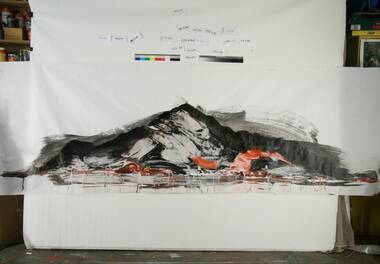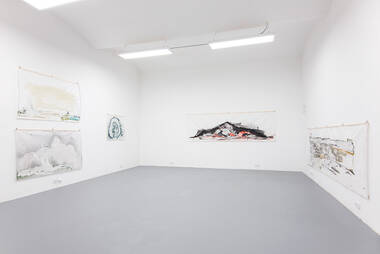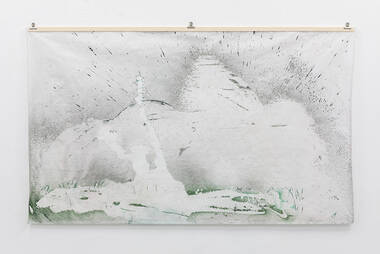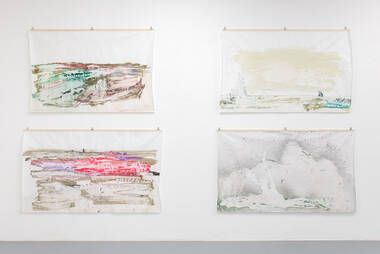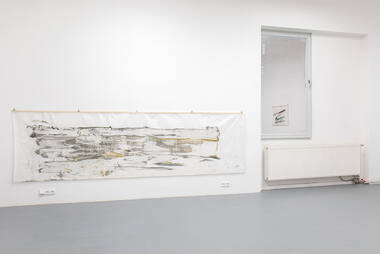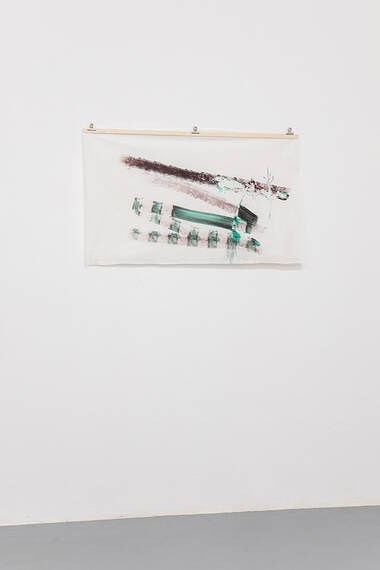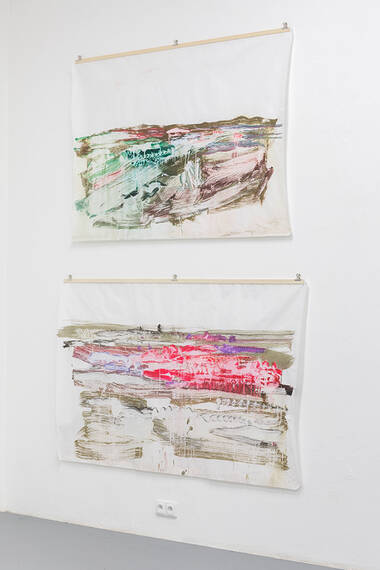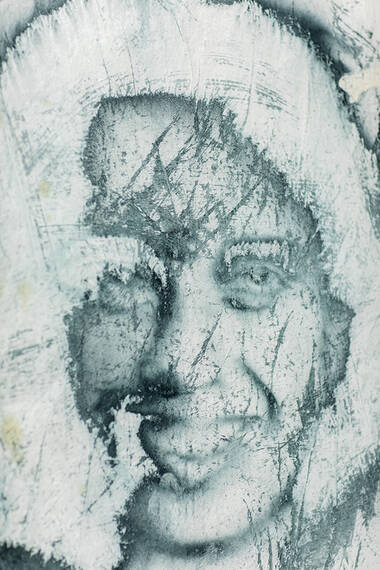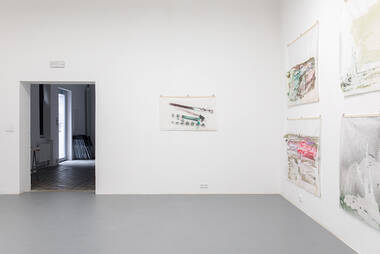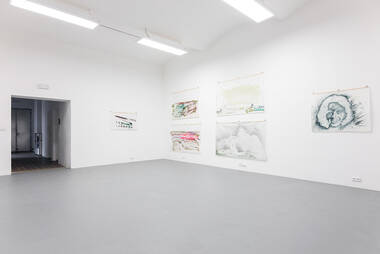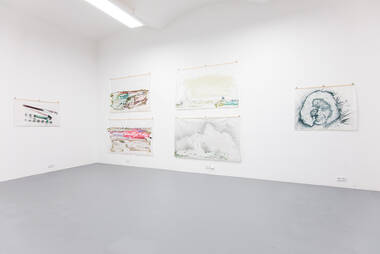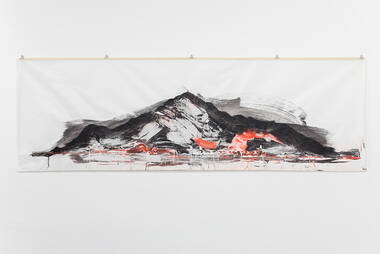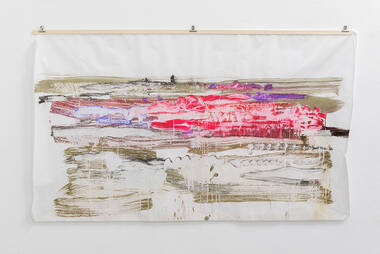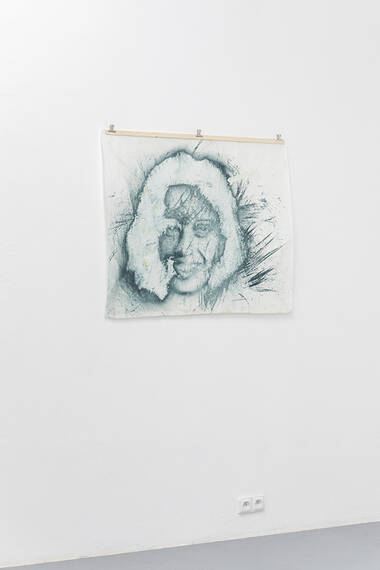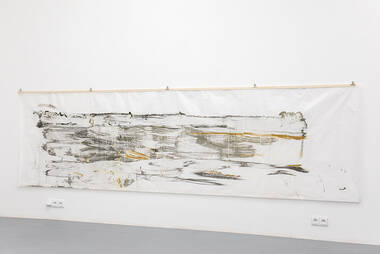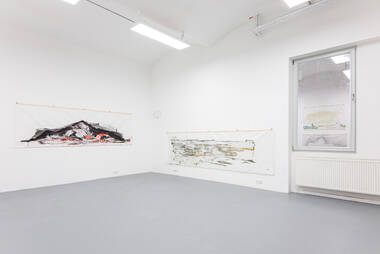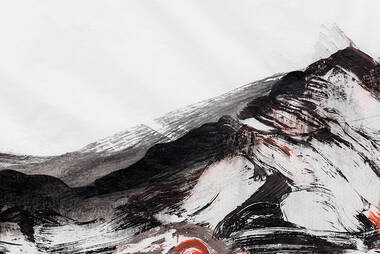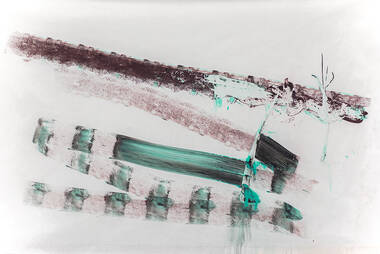Petr Pastrňák: Night Arunachala – Work
on Paper
21. 1. 2022 – 13. 2. 2022
opening: 20. 1. 2022 from 6 pm
curators: Gabriela Kotiková and Jiří Kovanda
GK: Petr, you belong to the same generation of artists as Jiří Surůvka or Petr Lysáček, who also come from Ostrava or its surroundings, and who significantly influenced the art scene during their time. Did you know each other before your studies at the Academy of Fine Arts (AVU), or did you meet in Prague?
PP: Jirka Surůvka, Petr Lysáček and I worked together in the theatre as scene shifters. They were painters and they organized exhibitions, so I brought over some of my things, so I could exhibit with them. Then when everyone was applying to the Academy in 1990, I sent my paintings in as well, and I was accepted to the studio of Milan Knížák.
GK: There are other artists who come from the same region including René Rohan, Vilém Kabzan, Jakub Špaňhel and others. Would you say that there was a lot happening back then in Ostrava and did you meet often in different places? Jiří Surůvka and then René Rohan ran a gallery there for quite some time….
PP: I left Ostrava in 1990 and I met all those you named in Prague.
GK: You studied at AVU in the studios of Milan Knížák, Michal Bielický and Jiří David. How would you characterize Milan Knížák’s teaching style? He taught many important artists and from what I’ve heard, he liked to assign “counter-projects” to different artists. For example, those who worked conceptually, he assigned them to paint in the style of 19th century painters, etc.
PP: If I was assigned to paint something based on a 19th century painter, I would be delighted, because I used to do that at one time and I really enjoyed it. I, on the contrary, was assigned other projects that led to creating various multimedia work. Naturally, I wanted to succeed, but I had to force myself to do something that did not come naturally to me. Although the results were liked by others, I did not enjoy it. Other than that, the studio functioned well, and it was definitely interesting to be there. The following year I received an offer to do an internship in Linz at the local Academy of Arts, Architecture and Design. So, I went and spent a year in Austria studying design. And then I spent a year in Michal Bielický’s Studio of Video. AVU offered various opportunities and it was tempting to try them all. But none of it felt right for me. Until, once in 1993, Bára Němcová and I ate magic mushrooms at her cottage in Český ráj, and that was a breaking point for me, in all respects. It opened my eyes. I realized what I’m supposed to do in life. Subsequently, I started playing with colours and I started painting abstract paintings. I applied to Jiří David’s studio in my last year when it became clear to me that I would only paint from then on.
GK: You often exhibited in exhibitions organized by Mr. and Mrs. Ševčík. You also collaborated with MXM Gallery. Back then, there were not many artists in the Czech Republic that created abstract paintings. One important figure during that time was Jiří Georg Dokoupil. Did you know him personally and did you like his work?
PP: Mr. and Mrs. Ševčík used to visit Milan Knížák’s studio. They liked my school work and exhibited it at several collective exhibitions. But the things I used to do at school back then did not represent a path for me that I wanted to pursue. Our collaboration started later, when I began painting abstract paintings. They accepted me in MXM Gallery, which was truly an honour for me. I did not meet Jiří Dokoupil until later. We shared a studio together with Jakub Špaňhel. Meeting him was very important to me in many respects. Not because I could see how he paints, but because of the entire conception of his work. He advised me, for example, that I need to completely exhaust every topic, which I had never done before. I would just start everything. And this changed for me after that.
GK: When you paint, do you like to paint from photographs? Is it better than plain air painting? And is it perhaps because there are many disruptive elements outdoors that break up your concentration?
PP: I like to use some kind of a picture to paint from. It is often a motif that I have known for a long time. I initially try to capture it somehow and if it doesn’t turn out, then I take it in a different direction. The picture is only like foundation that evolves into something. It’s really not that simple for me to start painting an abstract painting from nothing. That’s why it’s a good idea to use something to paint from and then it evolves on its own. Sometimes, I paint directly, other times I use a projection, but the actual picture I paint from is not that important. It is crucial not to miss the moment when something special emerges on the painting, which is not always possible because it does not have to be obvious right away. Once in a while, I try to paint outside, but I don’t expect any more convincing results. The important thing for me is to reach some new event that takes place on the canvas. For that to happen, I need to concentrate and I need the comfort of the studio.
K: In which year did you go to India for the first time and when did you decide you wanted to spend more time there?
PP: I came here in 2004, and in the beginning, I would spend six months a year in India, then it continued to get longer and now I’m here most of the year.
GK: The paintings currently on exhibit in Jelení Gallery are acrylic paint applied by brush on paper. Sometimes you also use the spray gun technique or washing out of the paint. How does this washing out technique work?
PP: Essentially, when the painting is finished, just before it is dry, I flush it out with water. There is lots of space for unexpected inversions that take it to another level. It creates a sort of negative effect, which I enjoy.
GK: In the exhibition, we can see India’s sacred mountain Arunachala.
Which part of India do you live in? Do you ever have to opportunity to paint it directly and spend time looking at it?
PP: I live in southern India near Arunachala Hill in an ashram, where I work in the garden. Although I can see the mountain from here, when I paint, I use a picture or a drawing that I’ve created. But I don’t usually paint the final painting on the spot.
GK: Another interesting painting in this exhibition is the portrait. Could you specify who is captured on it and the technique you used?
PP: It’s painted with a spray gun; I use a normal large spray gun. The portrait is of one woman here in India that I like.
GK: Did these pieces of work originate in India, or do you paint when you are in Czech? And which period are these works on paper that are presented at this exhibition from?
PP: The pieces of work at the exhibition originated between 2003 and 2008. I did them all during the time I was in the Czech Republic. I did not use to paint in India very much at that time, I was just experimenting. I was mostly creating the works on paper as proofs of what I was going to paint on canvas. Of course, it often happens that these papers turn out better than the canvases. I find paper, with its fineness, more suitable for this type of work. But it’s difficult to exhibit them. You need special frames and to put them under glass, it’s a lot of hassle. That’s why I never exhibited large format papers. But now I’m really excited how you managed to install them in the gallery; I was always worried about that.
The program of the Jeleni Gallery is possible through kind support of Ministry of Culture of the Czech Republic, Prague City Council, State Fund of Culture of the Czech Republic, City District Prague 7, GESTOR – The Union for the Protection of Authorship
Partners: Kostka stav
Media partners: ArtMap, jlbjlt.net, Náš REGION
and Mladý svět and UMA: You Make Art
